| Article ID | Journal | Published Year | Pages | File Type |
|---|---|---|---|---|
| 1034995 | Journal of Anthropological Archaeology | 2012 | 22 Pages |
Combined application of GIS modeling of polity boundaries and qualitative characterization of those boundaries in the Tuxtla Mountains, southern Veracruz, Mexico generated interesting questions and some answers regarding the regional political landscape. Not only did this process elucidate possible boundary locations, the process of evaluating these different hypotheses proved to be a useful exercise in characterizing the boundary and the nature of interaction between the polities controlled by Matacapan and Totocapan during the Classic period. I develop a seven variable classification for political boundaries to be used with coarse-grained settlement data.
► GIS models provide political boundary hypotheses for the Classic Tuxtla Mountains. ► Artifact and architectural styles are used to evaluate the hypotheses. ► The political boundary is characterized based on seven qualitative variables.
